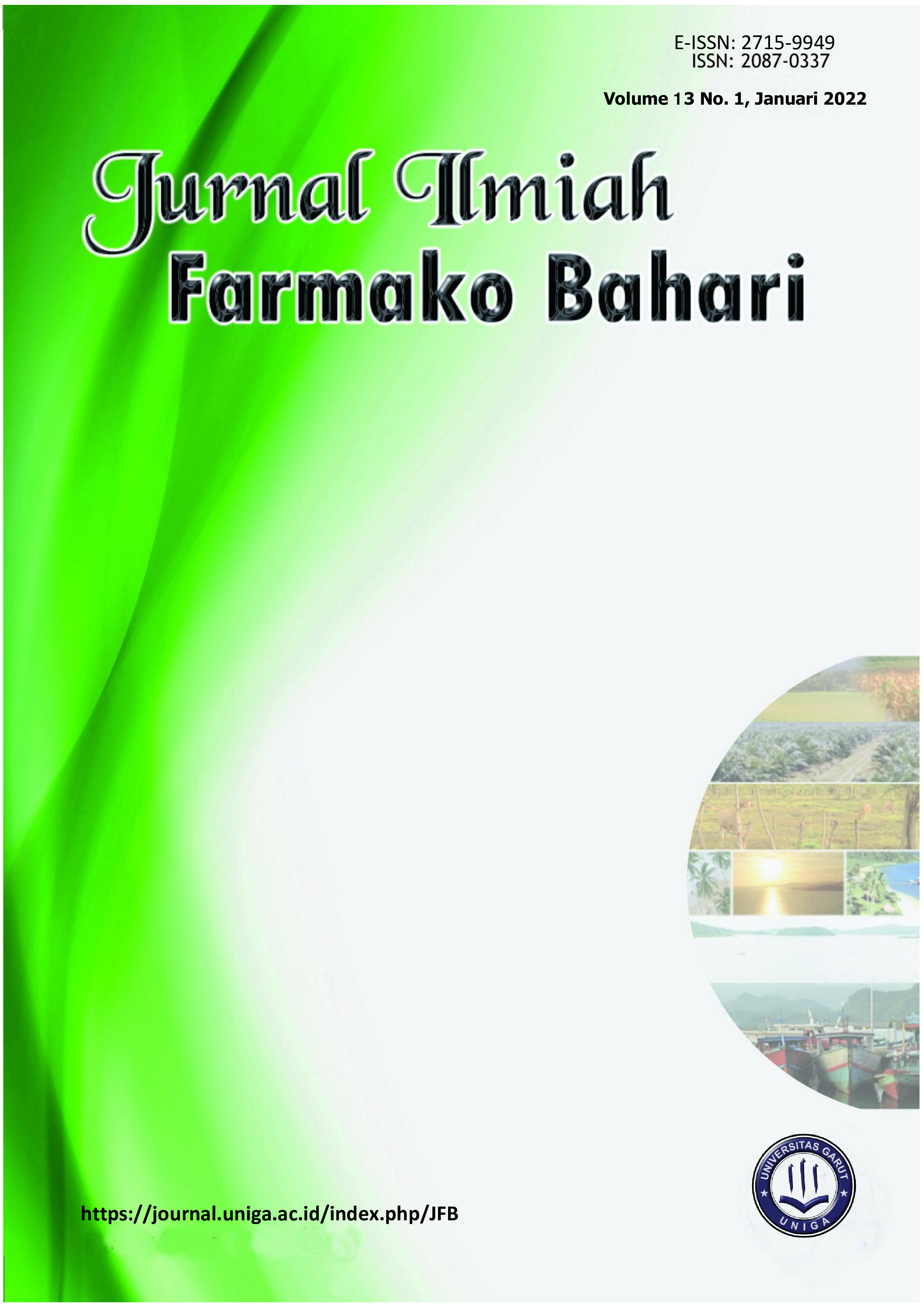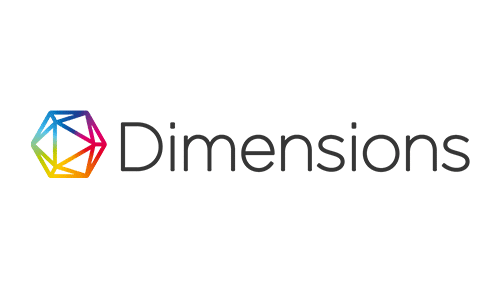EKSTRAKSI BERBANTU ULTRASONIK DAN AKTIVITAS ANTIOKSIDAN EKSTRAK UMBI GADUNG (Dioscorea hispida Dennst) SECARA IN VITRO
DOI:
https://doi.org/10.52434/jfb.v13i1.1240Keywords:
antioksidan, fenol, gadung, ultrasonic-assisted extractionAbstract
Dioscorea hispida Dennst atau di Indonesia dikenal dengan umbi gadung diketahui mengandung senyawa aktif fenol yang dapat memberikan aktivitas antioksidan. Ekstraksi senyawa fenol dari umbi gadung masih belum banyak diteliti. Tujuan penelitian ini adalah untuk mengekstraksi senyawa fenol menggunakan metode ultrasonic-assisted extraction (UAE) dengan pelarut yang bervariasi yaitu air, etanol, dan metanol serta menguji aktivitas antioksidannya. Penentuan kandungan fenol total (TPC) ekstrak secara kuantitatif telah dilakukan menggunakan metode spektrofotometri uv-vis dengan prinsip reaksi reduksi antara Folin–Ciocalteu dengan asam galat. Pengujian aktivitas antioksidan ekstrak menggunakan metode peredaman 2,2-difenil-1-pikrilhidrazil (DPPH). Dari penelitian ini diketahui bahwa senyawa fenol total paling tinggi terdapat pada ekstrak metanol umbi gadung yaitu sebesar 4,467 ± 0,752 gGAE/100 g dengan aktivitas antioksidan terkuat yang dilihat dari nilai IC50-nya yaitu sebesar 4,395 μg/mL.
References
Nugroho LH, Anna E. The potency of gadung (Dioscorea hispida Dennst.) tuber as a functional food: toxicicty, phytochemical content and starch characters. AIP Conf Proc 2002. 2018; Available from: doi: https://doi.org/10.1063/1.5050133
Masdar N, Roslan R, Hasan S&, Kamal M. Determination of antioxidant from ubi gadong tubers for facial soap bar. In: Charting the Sustainable Future of ASEAN in Science and Technology. Singapore: Springer; 2020. Available from: https://doi.org/10.1007/978-981-15-3434-8_17%5C
Kresnadipayana D, Helmy I. The concentration of NaCl soaking to decreasing cyanide levels in Gadung (Dioscorea hispida Dennst). J Teknol Lab. 2019;8(1):36–40. Available from: doi: 10.29238/teknolabjournal.v8i1.156.
Gunawan S, Aparamarta B, Anindita, Antari A. Effect of fermentation time on the quality of modified gadung flour from gadung tuber (Dioscorea hispida Dennst.). In: IOP Conf Series: Materials Science and Engineering 673, 012002. 2019. Available from: doi:10.1088/1757-899X/673/1/012002
Kumoro A, Retnowati D, Budiyati C. Removal of cyanides from gadung (Dioscorea hispida dennst.) tuber chips using leaching and steaming techniques. J Appl Sci Res. 2011;7(12):2140–6.
Sari D, Fitrawati, Bahtiar. Effect of Dioscorea hispida dennst. against Rattus sp. In: IOP Conf Series: Earth and Environmental Science 484, 012109. 2020. Available from: doi:10.1088/1755-1315/484/1/012109
Putri A, Kurniasih E, Hasanah U, Rahmawati. Isolation of prebiotic inulin from Gadung Aceh tuber (Dioscorea hispida) using hydrolysis reaction. In: IOP Conf Series: Materials Science and Engineering 725, 012061. 2020. Available from: doi:10.1088/1757-899X/725/1/012061
Padhan B, Nayak J, Panda D. Natural antioxidant potential of selected underutilized wild yams (Dioscorea spp.) for health benefit. J Food Sci Technol. 57:2370–2376.
Raina, Archana P, Misra R. Evaluation of diosgenin, a bioactive compound from natural source of dioscorea species: a wild edible tuber plant. J Pharmacogn Phytochem. 2019;9(1):1120–4.
Kumar T, Murthy G, Suresh A, Suresh V, Kumar N, Raviashanka H. Evaluation of antitumour activity and antioxidant status in Dioscorea hispida Dennst. leaves on Ehrlich Ascites Carcinoma in Swiss Albino Mice. J Drug Dev Res. 2011;3(2):203–210.
Susanti, Mardianingru R. Antibacterial activity of methanol extract of gadung tubers (Dioscorea hispida dennst.) against Propionibacterium acnes. Farmagazine. 2020;7(1):13–7.
Miah M, Das P, Ibrahim Y, Shajib M, Rashid M. In vitro antioxidant, antimicrobial, membrane stabilization and thrombolytic activities of dioscorea hispida dennst. Eur J Integr Med. 2018;19:121–7. Available from: doi: 10.1016/j.eujim.2018.02.002
Kumar S, Das G, H.S. Shin H, Patra J. Dioscorea spp (a wild edible tuber): a study on its ethnopharmacological potential and traditional use by the local people of similipal biosphere reserve, India. Pharmacol. 2017;8(52):1–17. Available from: doi: 10.3389/fphar.2017.00052
Lim T. Edible medicinal and non-medicinal plants, modified stems, roots, bulbs. Dordrecht,Netherlands: Springer; 2016.
Moure A, Cruz J, Franco D, DomÃnguez J, Sineiro J, DomÃnguez H, et al. Natural antioxidants from residual sources. Food Chem. 2001;72(2):145–171. Available from: doi: 10.1016/S0308-8146(00)00223-5
Lobo V, Patil A, Phatak A, Chandra N. Free radicals, antioxidants and functional foods: impact on human health. Pharmacogn Rev. 2010;4(8):118–26. Available from: doi: 10.4103/0973-7847.70902
Theerasin S, Baker A. Analysis and identification of phenolic compounds in Dioscorea hispida dennst. Asian J Food Agro-Industry. 2009;2(4):547–60.
Sari S, Berna E, Katrin. Determination of specifc and non-specifc parameters of simplicia and ethanolic 70% extract of gadung tubers (Dioscorea hispida). Pharmacogn J. 2019;11(4):759–63.
Susanti R, Mardianingrum S, Yuliawati, Ferbriani Y. pengaruh lama ekstraksi terhadap kadar fenol total ekstrak metanol daging umbi gadung (Dioscorea hispida dennst.). J Pharmacopolium. 2019;3(1):149–55. Available from: doi: 10.36465/jop.v2i3.541
Chaoting W, Zhang J, Zhang H, Courage Sede DMZ, Yuqing D, Ma H, et al. Advances in ultrasound assisted extraction of bioactive compounds from cash crops – A review. Ultrason Sonochem. 2018;48:538–49. Available from: https://doi.org/10.1016/j.ultsonch.2018.07.018
Lide D. CRC handbook of chemistry and physics: 8th Edition. Boca Raton: CLC Press; 2005.
Verdiana M, Widarta I, Permana, D.G.M I. Pengaruh jenis pelarut pada ekstraksi menggunakan gelombang ultrasonik terhadap aktivitas antioksidan ekstrak kulit buah lemon (Citrus limon (Linn.) Burm F.). J Ilmu dan Teknol Pangan. 2018;7(4):213–22.
Salim S, Saputri F, Saptarini N, Levita J. Review artikel: kelebihan dan keterbatasan pereaksi folin-ciocalteu dalam penentuan kadar fenol total pada tanaman. Farmaka. 2020;18(1):46–57.
Margraf T, Karnopp A, Rosso N, Granato D. Comparison between folin-ciocalteu and prussian blue assays to estimate the total phenolic content of juices and teas using 96-well microplates. J Food Sci. 2015;80(11):2397–403.
Dris R, Jain S. Production practices and quality assessment of food. In: crops: quality handling and evaluation. New York: Kluwer Academic; 2004.
Molyneux P. The use of the stable free radical diphenylpicryl-hydrazyl (DPPH) for estimating antioxidant activity. Songklanakarin J Sci Technol. 2004;26(2):211–9.
Blois M. Antioxidant determinations by the use of a stable free radical. Nature. 1958;181:1199–1200.
Johari M, Khong H. Total phenolic content and antioxidant and antibacterial activities of pereskia bleo. Hindawi Adv Pharmacol Sci. 2019;2019:1–4.
Kahkonen M, Hopia A, Vourela H, Rauha J, Pihlaja K, Kujala T, et al. Antioxidant activity of extract containing phenolic compounds. J Agric Food Chem. 1999;47(10).
Downloads
Published
Issue
Section
License
or all articles published in Jurnal Ilmiah Farmako Bahari, the copyright is retained by the journal. Articles are published under the terms of Creative Commons Attribution-ShareAlike 4.0 International License (CC-BY-SA 4.0) . For Authors:
|


1.png) Download Journal Template
Download Journal Template
.png)









